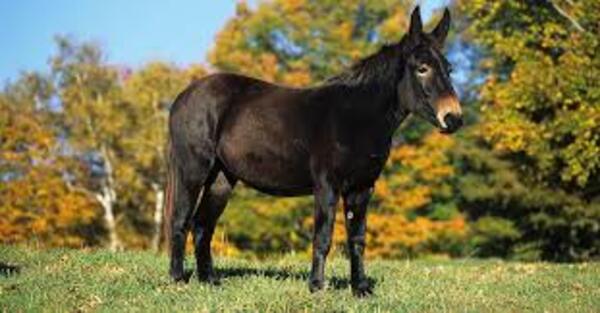When it comes to hybrid animals, mules and hinnies are among the most fascinating. Although they share similarities, their differences are crucial to understanding their characteristics and uses. In this article, we will delve into the distinctions between mules and hinnies, providing detailed comparisons and a helpful table for clarity.
Mules are hybrids resulting from the breeding of a male donkey (jack) and a female horse (mare). They inherit desirable traits from both parents, combining the strength of a horse with the endurance of a donkey.
Hinnies, on the other hand, are produced by crossing a female donkey (jenny) with a male horse (stallion). While they share some similarities with mules, hinnies tend to exhibit different characteristics due to their parentage.
Origin History: Mules are hybrids that arise from the mating of a male donkey (jack) and a female horse (mare). The origins of mules date back thousands of years, with evidence suggesting that they were first bred in ancient Mesopotamia around 3,000 BCE. Their development was likely driven by the need for a robust animal capable of carrying heavy loads and enduring harsh conditions.
The unique combination of a horse's size and strength with a donkey's stamina and sure-footedness made mules highly valuable for agriculture, transportation, and warfare. Ancient civilizations, such as the Egyptians and Romans, utilized mules for various tasks, recognizing their intelligence and versatility. Over the centuries, selective breeding has continued to enhance the traits of mules, making them indispensable in many cultures worldwide.

Origin History: Hinnies, the result of crossing a female donkey (jenny) with a male horse (stallion), have a less documented history compared to mules. They likely emerged as a byproduct of the close coexistence of horses and donkeys in ancient agrarian societies. The practice of breeding hinnies may have been less common due to the jenny's smaller size and different reproductive behaviors.
Hinnies have historically been seen as less favorable compared to mules, primarily due to their smaller stature and temperament. They were used in some cultures for similar purposes as mules but never achieved the same level of popularity or utility. As with mules, hinnies have been bred over time, though their numbers are significantly lower, leading to a lesser impact in agriculture and transport.

Both mules and hinnies arose from the intersection of donkey and horse breeding, serving as valuable animals for human societies throughout history. While mules became widely recognized and utilized for their strength and versatility, hinnies remained relatively obscure, highlighting the fascinating complexities of hybridization in the animal kingdom.
| Feature | Mules | Hinnies |
|---|---|---|
| Parentage | Male donkey (jack) + Female horse (mare) | Female donkey (jenny) + Male horse (stallion) |
| Physical Appearance | Generally larger, horse-like build with longer ears | Smaller, more donkey-like build, shorter ears |
| Temperament | Often more trainable and calm | Typically more stubborn and harder to train |
| Reproductive Capability | Usually sterile | Also usually sterile |
| Coat Texture | Smoother, more horse-like fur | Coarser, resembling donkey fur |
| Common Uses | Work animals, pack animals, riding | Rarely used for work or riding |
| Lifespan | 25-30 years | 25-30 years |
| Sound | Makes a sound called a "bray," similar to a donkey | Also brays but may sound slightly different |
Parentage: The distinction in parentage is the most significant difference. Mules inherit the best qualities from both horses and donkeys, while hinnies reflect a different blend of traits.
Physical Appearance: Mules tend to be larger and more muscular, displaying a blend of horse features. Hinnies, however, retain more donkey characteristics, making them smaller and often more compact.
Temperament: Mules are known for their intelligence and adaptability, which makes them easier to train. Hinnies may exhibit a more stubborn demeanor, potentially making them challenging for inexperienced handlers.
Reproductive Capability: Both mules and hinnies are typically sterile due to the differing chromosome counts of their parent species. This sterility is a common trait among hybrids.
Coat Texture: Mules usually have a smoother coat, akin to that of horses, while hinnies often display a coarser texture, resembling their donkey heritage.
Common Uses: Mules are commonly used in agriculture and transportation due to their strength and endurance. Hinnies are less common and are not typically used for these purposes.
Lifespan: Both hybrids enjoy a similar lifespan, ranging from 25 to 30 years, depending on care and environment.
Sound: The braying sound made by mules is often deeper and more resonant than that of hinnies, which can be slightly higher-pitched.
Understanding the differences between mules and hinnies not only enriches our knowledge of these remarkable hybrids but also aids in their proper care and utilization. Whether you’re considering one for work or companionship, recognizing their unique traits can enhance the relationship you build with these animals.
By grasping the distinctions between mules and hinnies, you can appreciate the diversity of hybrid animals and the fascinating ways in which they serve human needs.
We created this article in conjunction with AI technology, then made sure it was fact-checked and edited by a Animals Top editor.